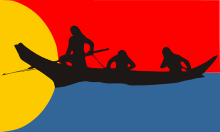The tribe is first reported in the 1792 journals of Robert Gray. Members were encountered at the mouth of Columbia in 1805 by the Lewis and Clark Expedition. The expedition named their last encampment Fort Clatsop after the tribe, whose nearest major village was approximately 7 miles away. Clatsop County, Oregon was named after this tribe. According to the journals of William Clark, the Clatsop comprised about 200 people living in three separate villages, with large longhouses constructed of cedar planks. Clatsop members regularly visited the fort to trade furs and other goods for European manufactured goods. for trading purposes.
The tribe had designated headmen (or "chiefs") but was socially flexible. Individual families affiliated with one another in small villages and seasonal camps located near food sources.
The Clatsop shared salmon, berries, and hunting tips with the Corps of Discovery. In contrast to the Corps' interactions with the Plains Indians the previous winter, their interaction with the Clatsop was more limited. The two groups did not mingle for social occasions, and the fort was opened to trading only 24 days during the winter. Part of the reason may have been that the coastal tribes had an existing relationship with British traders. The Clatsop and Chinook asked for higher prices from the American expedition for their goods at a time when the Corps' supply of "Indian gifts" had dwindled. Only two Clatsop, Coboway and Cuscalar, are regularly named in the Corps members' journals.
In an 1851 treaty, the Clatsop tribe proposed to cede 90 percent of their land to the U.S. Government. This treaty was one of many in the Northwest that were never ratified by Senate. Unlike other tribes, the members were not required to move to a reservation. They were one of the only tribes in Oregon that was not the focus of an organized effort to remove them to reservations.
